STL源码分析学习笔记(allocator)
以STL的运用角度而言,空间配置器是最不需要介绍的东西,它总是隐藏在一切组件(更具体地说是指容器,container)的背后,默默工作,默默付出。但若以STL的实现角度而言,第一个需要介绍的就是空间配置器,因为整个STL的操作对象(所有的数值)都存放在容器之内,而容器一定需要配置空间以置放资料。不先掌握空间配置器的原理,难免在阅读其他STL组件的实现时处处遇到拦路石。
为什么不说allocator是内存配置器而说它是空间配置器呢?因为空间不一定是内存,空间也可以是磁盘或其他辅助存储介质。是的,你可以写一个allocator,直接向硬盘取空间。以下介绍的是SGI STL提供的配置器,配置的对象,呃,是的,是内存。
1. 空间配置器的标准接口
根据STL的规范,以下是allocator的必要接口(截取自stl_alloc.h):
template <class _Tp>
class allocator {
typedef alloc _Alloc; // The underlying allocator.
public:
typedef size_t size_type;
typedef ptrdiff_t difference_type;
typedef _Tp* pointer;
typedef const _Tp* const_pointer;
typedef _Tp& reference;
typedef const _Tp& const_reference;
typedef _Tp value_type;
template <class _Tp1> struct rebind {
typedef allocator<_Tp1> other;
};
allocator() __STL_NOTHROW {}
allocator(const allocator&) __STL_NOTHROW {}
//泛化的copy constructor
template <class _Tp1> allocator(const allocator<_Tp1>&) __STL_NOTHROW {}
~allocator() __STL_NOTHROW {}
pointer address(reference __x) const { return &__x; }
const_pointer address(const_reference __x) const { return &__x; }
// __n is permitted to be 0. The C++ standard says nothing about what
// the return value is when __n == 0.
_Tp* allocate(size_type __n, const void* = 0) {
return __n != 0 ? static_cast<_Tp*>(_Alloc::allocate(__n * sizeof(_Tp)))
: 0;
}
// __p is not permitted to be a null pointer.
void deallocate(pointer __p, size_type __n)
{ _Alloc::deallocate(__p, __n * sizeof(_Tp)); }
size_type max_size() const __STL_NOTHROW
{ return size_t(-1) / sizeof(_Tp); }
void construct(pointer __p, const _Tp& __val) { new(__p) _Tp(__val); }
void destroy(pointer __p) { __p->~_Tp(); }
};1.1 设计一个简单的空间配置器
根据前述的标准接口,我们可以自行完成一个功能简单、接口不怎么齐全的allocator如下(jjalloc.h):
#ifndef _JJALLOC_
#define _JJALLOC_
#include <new> //for placement new
#include <cstddef> //for ptrdiff_t, size_t
#include <cstdlib> //for exit()
#include <climits> //for UINT_MAX
#include <iostream> //for cerr
namespace JJ{
template <class T>
inline T* _allocate(ptrdiff_t size, T*)
{
set_new_handler(0);
T *tmp = (T *)(::operator new((size_t)(size * sizeof(T))));
if(tmp == 0){
std::cerr << "out of memory" << std::endl;
exit(1);
}
return tmp;
}
template <class T>
inline void _deallocate(T *buffer)
{
::operator delete(buffer);
}
template<class T1, class T2>
inline void _construct(T1 *p, const T2& value)
{
new(p) T2(value);
}
template <class T>
inline void _destory(T *ptr)
{
ptr->~T();
}
template<class T>
class allocator{
public:
typedef T value_type;
typedef T* pointer;
typedef const T* const_pointer;
typedef T& reference;
typedef const T& const_reference;
typedef size_t size_type;
typedef ptrdiff_t difference_type; //ptrdiff_t类型变量通常用来保存两个指针减法操作的结果
//rebind allocator of type U
template <class U>
struct rebind{
typedef allocator<U> other;
};
//hint used for locality.
pointer allocate(size_type n, const void *hint = 0)
{
return _allocate((difference_type)n, (pointer)0);
}
void deallocate(pointer p, size_type n)
{
_deallocate(p);
}
void construct(pointer p, const T& value){
_construct(p, value);
}
void destroy(pointer p){
_destory(p);
}
pointer address(reference x){
return (pointer)&x;
}
const_pointer address(const_reference x)
{
return (const_pointer)&x;
}
size_type max_size() const{
return size_type(UINT_MAX)/sizeof(T);
}
};
}
#endif将JJ::allocator应用于程序之中,我们发现,它只能有限度地搭配PJ STL和RW STL,例如(jjalloc.cpp):
#include "jjalloc.h"
#include <vector>
#include <iostream>
using namespace std;
int main(int argc, char *argv[])
{
int ia[5] = {0, 1, 2, 3, 4};
unsigned int i;
vector<int, JJ::allocator<int> > iv(ia, ia+5);
for(i = 0; i<iv.size(); i++)
cout<<iv[i]<< ' ';
cout<<endl;
return 0x0;
}编译运行:
# gcc -fpermissive -o jjalloc jjalloc.cpp -lstdc++ # ./jjalloc 0 1 2 3 4
“只能有限度搭配PJ STL”是因为,PJ STL未完全遵循STL规格,其所供应的许多容器都需要一个非标准的空间配置器接口allocator::_Charalloc()。“只能有限度的搭配RW STL”则是因为,RW STL在许多容器上运用了缓冲区,情况复杂得多,JJ::allocator无法与之兼容。至于完全无法应用于SGI STL,是因为SGI STL在这个项目上根本就逸脱了STL标准规格,使用一个专属的、拥有次层(sub-allocation)能力的、效率优越的特殊配置器,稍后有详细介绍。
注:对比新版SGI STL v3.3中allocator的实现,JJ::allocator应该是可以兼容的。
我想我可以提前先做一点说明。事实上SGI STL仍然提供了一个标准的配置器接口,只是把它做了一层隐藏。这个标准的配置器名为simple_alloc,稍后便会提到。
2. 具备次配置力(sub-allocation)的SGI空间配置器
SGI STL的配置器与众不同,也与标准规范不同,其名称为alloc而非allocator,而且不接受任何参数。换句话说,如果你要在程序中明白采用SGI配置器,则不能采用标准写法:
vector<int, std::allocator<int> > iv; //in VC or CB必须这么写:
vector<int, std::alloc> iv; //in GCC说明:在SGI STL v3.3版本stl_config.h中,默认是采用std::alloc而非std::allocator
// Use standard-conforming allocators if we have the necessary language
// features. __STL_USE_SGI_ALLOCATORS is a hook so that users can
// disable new-style allocators, and continue to use the same kind of
// allocators as before, without having to edit library headers.
# if defined(__STL_CLASS_PARTIAL_SPECIALIZATION) && \
defined(__STL_MEMBER_TEMPLATES) && \
defined(__STL_MEMBER_TEMPLATE_CLASSES) && \
!defined(__STL_NO_BOOL) && \
!defined(__STL_NON_TYPE_TMPL_PARAM_BUG) && \
!defined(__STL_LIMITED_DEFAULT_TEMPLATES) && \
!defined(__STL_USE_SGI_ALLOCATORS)
# define __STL_USE_STD_ALLOCATORS
# endif
# ifndef __STL_DEFAULT_ALLOCATOR
# ifdef __STL_USE_STD_ALLOCATORS
# define __STL_DEFAULT_ALLOCATOR(T) allocator< T >
# else
# define __STL_DEFAULT_ALLOCATOR(T) alloc
# endif
# endifSGI STL allocator未能符合标准规格(注:新版SGI STL v3.3中allocator似乎已经符合了标准规格),这个事实通常不会给我们带来困扰,因为通常我们使用缺省的空间配置器,很少需要自行指定配置器名称,而SGI STL的每一个容器都已经指定其缺省的空间配置器为alloc。例如下面的vector声明:
template <class _Tp, class _Alloc = __STL_DEFAULT_ALLOCATOR(_Tp) >
class vector : protected _Vector_base<_Tp, _Alloc>
{
// requirements:
};2.1 SGI标准的空间配置器std::allocator
在SGI STL v3.3版本中,SGI提供的std::allocator似乎已经已经符合了标准,这里不再对其进行说明。
2.2 SGI特殊的空间配置器std::alloc
一般而言,我们所习惯的C++内存配置操作和释放操作是这样的:
class Foo{...};
Foo *pf = new Foo; //内存配置,然后构造对象
delete pf; //将对象析构,然后释放内存这其中的new算式内含两阶段操作:1) 调用::operator new配置内存;2) 调用Foo::Foo()构造对象内容。delete算式也内含两阶段操作:1)调用Foo::~Foo()将对象析构;2)调用::operator delete释放内存。
为了精密分工,STL allocator决定将这两阶段操作区分开来。内存配置操作由alloc::allocate()负责,内存释放操作由alloc::deallocate()负责;对象构造操作由::construct()负责,对象析构由::destroy()负责。
STL标准规格告诉我们,配置器定义于<memory>之中,SGI <memory>内含以下两个文件:
#include <stl_alloc.h> //负责内存空间的配置与释放
#include <stl_construct.h> //负责对象内容的构造与析构内存空间的配置/释放与对象内容的构造/析构,分别落在这两个文件身上。其中
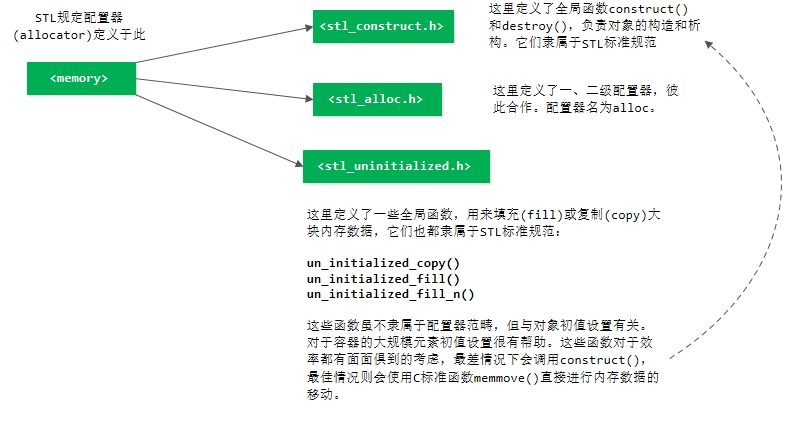
2.3 构造和析构基本工具: construct()和destory()
下面是
#include <new.h> //欲使用placement new,需先包含此文件
template <class _T1, class _T2>
inline void _Construct(_T1* __p, const _T2& __value) {
new ((void*) __p) _T1(__value);
}
template <class _T1>
inline void _Construct(_T1* __p) {
new ((void*) __p) _T1();
}
template <class _Tp>
inline void _Destroy(_Tp* __pointer) {
__pointer->~_Tp();
}
template <class _ForwardIterator>
void
__destroy_aux(_ForwardIterator __first, _ForwardIterator __last, __false_type)
{
for ( ; __first != __last; ++__first)
destroy(&*__first);
}
template <class _ForwardIterator>
inline void __destroy_aux(_ForwardIterator, _ForwardIterator, __true_type) {}
//如果元素的数值型别(value type)有non-trival destructor...
template <class _ForwardIterator, class _Tp>
inline void
__destroy(_ForwardIterator __first, _ForwardIterator __last, _Tp*)
{
typedef typename __type_traits<_Tp>::has_trivial_destructor
_Trivial_destructor;
__destroy_aux(__first, __last, _Trivial_destructor());
}
template <class _ForwardIterator>
inline void _Destroy(_ForwardIterator __first, _ForwardIterator __last) {
__destroy(__first, __last, __VALUE_TYPE(__first));
}
inline void _Destroy(char*, char*) {}
inline void _Destroy(int*, int*) {}
inline void _Destroy(long*, long*) {}
inline void _Destroy(float*, float*) {}
inline void _Destroy(double*, double*) {}
#ifdef __STL_HAS_WCHAR_T
inline void _Destroy(wchar_t*, wchar_t*) {}
#endif /* __STL_HAS_WCHAR_T */这两个作为构造、析构之用的函数被设计为全局函数,符合STL的规范。此外,STL还规定配置器必须拥有名为construct()和destroy()的两个成员函数,然而真正在SGI STL中大显身手的那个名为std::alloc的配置器并未遵守这一规则(稍后可见)
上述construct()接受一个指针p和一个初值value,该函数的用途就是将初值设定到指针所指的空间上。C++的placement new运算子可用来完成这一任务。
destroy()有两个版本,第一个版本接受一个指针,准备将该指针所指之物析构掉。这很简单,直接调用该对象的析构函数即可。第二版本接受first和last两个迭代器(所谓迭代器,我们会在后面第3章进行详细介绍),准备将[first, last)范围内的所有对象析构掉。我们不知道这个范围有多大,万一很大,而每个对象的析构函数都无关痛痒(所谓trival destructor),那么一次次调用这些无关痛痒的析构函数,对效率是一种伤害。因此,这里首先利用__VALUE_TYPE()获得迭代器所指对象的型别,再利用__type_traits<T>判断该型别的析构函数是否无关痛痒。若是(__true_type),则什么也不做就结束;否则(__false_type),这才以循环方式巡访整个范围,并在循环中每经历一个对象就调用第一个版本的destroy()。
这样的观念很好,但C++本身并不支持对“指针所指之物”的型别判断,也不支持对“对象析构函数是否为trivial”的判断,因此,上述的__VALUE_TYPE()和__type_traits<>该如何实现呢?我们会在第3.7节有详细介绍。
2.4 空间的配置与释放
看完了内存配置后的对象构造行为和内存释放前的对象析构行为,现在我们来看看内存的配置和释放。
对象构造前的空间配置和对象析构后的空间释放,由<stl_alloc.h>负责,SGI对此的设计哲学如下:
-
向system heap要求空间;
-
考虑多线程(multi-threads)状态;
-
考虑内存不足时的应变措施;
-
考虑过多“小型区块”可能造成的内存碎片(fragment)问题;
为了将问题控制在一定的复杂度内,以下的讨论以及所摘录的源代码,皆排除多线程状态的处理。
C++的内存配置基本操作是::operator new(),内存释放基本操作是::operator delete()。这两个全局函数相当于C的malloc()和free()函数。是的,正是如此,SGI正是以malloc()和free()完成内存的配置与释放。
考虑到小型区块所可能造成的内存破碎问题,SGI设计了双层级配置器,第一级配置器直接使用malloc()和free(),第二级配置器则视情况采用不同的策略:当配置区块超过128bytes时,视之为“足够大”,便调用第一级配置器;当配置区块小于128bytes时,视之为“过小”,为了降低额外负担(overhead,见2.2.6节),便采用复杂的memory pool整理方式,而不再求助于第一级配置器。整个设计究竟只开放第一级配置器,或是同时开放第二级配置器,取决于__USE_MALLOC是否被定义(唔,我们可以轻易测试出来,SGI STL并未定义__USE_MALLOC):
# ifdef __USE_MALLOC
typedef __malloc_alloc_template<0> malloc_alloc;
typedef malloc_alloc alloc; //令alloc为第一级配置器
typedef malloc_alloc single_client_alloc;
# else
...
typedef __default_alloc_template<__NODE_ALLOCATOR_THREADS, 0> alloc; //令alloc为第二级配置器
typedef __default_alloc_template<false, 0> single_client_alloc;
#endif其中__malloc_alloc_template就是第一级配置器,__default_alloc_template就是第二级配置器。稍后分别有详细分析。再次提醒你注意,alloc并不接受任何templete型别参数。
无论alloc被定义为第一级或第二级配置器,SGI还为它再包装一个接口如下,使配置器的接口能够符合STL规格:
template<class _Tp, class _Alloc>
class simple_alloc {
public:
static _Tp* allocate(size_t __n)
{ return 0 == __n ? 0 : (_Tp*) _Alloc::allocate(__n * sizeof (_Tp)); }
static _Tp* allocate(void)
{ return (_Tp*) _Alloc::allocate(sizeof (_Tp)); }
static void deallocate(_Tp* __p, size_t __n)
{ if (0 != __n) _Alloc::deallocate(__p, __n * sizeof (_Tp)); }
static void deallocate(_Tp* __p)
{ _Alloc::deallocate(__p, sizeof (_Tp)); }
};其内部四个成员函数其实都是单纯的转调用,调用传递给配置器(可能是第一级也可能是第二级)的成员函数。这个接口使配置器的配置单位从bytes转为个别元素的大小(sizeof(T))。SGI STL容器全都使用这个simple_alloc接口,例如:
//stl_config.h
# ifndef __STL_DEFAULT_ALLOCATOR
# ifdef __STL_USE_STD_ALLOCATORS
# define __STL_DEFAULT_ALLOCATOR(T) allocator< T >
# else
# define __STL_DEFAULT_ALLOCATOR(T) alloc
# endif
# endif
template <class _Tp, class _Alloc>
class _Vector_base {
...
protected:
typedef simple_alloc<_Tp, _Alloc> _M_data_allocator;
_Tp* _M_allocate(size_t __n)
{ return _M_data_allocator::allocate(__n); }
void _M_deallocate(_Tp* __p, size_t __n)
{ _M_data_allocator::deallocate(__p, __n); }
};
template <class _Tp, class _Alloc = __STL_DEFAULT_ALLOCATOR(_Tp) >
class vector : protected _Vector_base<_Tp, _Alloc>
{
};一、二级配置器的关系,接口包装,及实际运用方式,可于图2-2略见端倪。
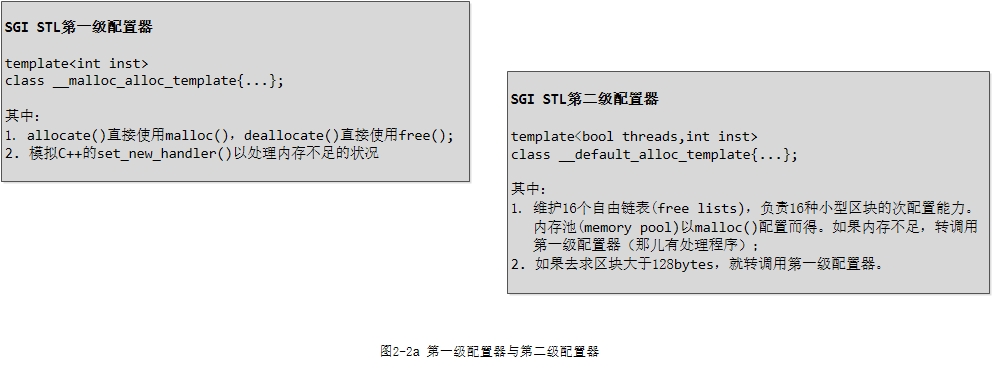

2.5 第一级配置器__malloc_alloc_template剖析
首先我们观察第一级配置器:
//malloc-based allocator. 通常比稍后介绍的default alloc速度慢
//一般而言是thread-safe,并且对于空间的运用比较高效(efficient)
//以下是第一级配置器
//注意,无“template型别参数”。至于“非型别参数”inst,则完全没有派上用场。
template <int __inst>
class __malloc_alloc_template {
private:
//以下函数用来处理内存不足的情况(oom: out of memory)
static void* _S_oom_malloc(size_t);
static void* _S_oom_realloc(void*, size_t);
#ifndef __STL_STATIC_TEMPLATE_MEMBER_BUG
static void (* __malloc_alloc_oom_handler)();
#endif
public:
static void* allocate(size_t __n)
{
void* __result = malloc(__n);
if (0 == __result) __result = _S_oom_malloc(__n); //当无法满足需求时,改用oom_malloc()
return __result;
}
static void deallocate(void* __p, size_t /* __n */)
{
free(__p);
}
static void* reallocate(void* __p, size_t /* old_sz */, size_t __new_sz)
{
void* __result = realloc(__p, __new_sz);
if (0 == __result) __result = _S_oom_realloc(__p, __new_sz);
return __result;
}
static void (* __set_malloc_handler(void (*__f)()))()
{
void (* __old)() = __malloc_alloc_oom_handler;
__malloc_alloc_oom_handler = __f;
return(__old);
}
};
// malloc_alloc out-of-memory handling
#ifndef __STL_STATIC_TEMPLATE_MEMBER_BUG
template <int __inst>
void (* __malloc_alloc_template<__inst>::__malloc_alloc_oom_handler)() = 0;
#endif
template <int __inst>
void*
__malloc_alloc_template<__inst>::_S_oom_malloc(size_t __n)
{
void (* __my_malloc_handler)();
void* __result;
for (;;) { //不断尝试释放、配置、在释放、再配置....
__my_malloc_handler = __malloc_alloc_oom_handler;
if (0 == __my_malloc_handler) { __THROW_BAD_ALLOC; }
(*__my_malloc_handler)(); //调用处理例程,企图释放内存
__result = malloc(__n); //再次尝试配置内存
if (__result) return(__result);
}
}
template <int __inst>
void* __malloc_alloc_template<__inst>::_S_oom_realloc(void* __p, size_t __n)
{
void (* __my_malloc_handler)();
void* __result;
for (;;) { //不断尝试释放、配置、在释放、再配置....
__my_malloc_handler = __malloc_alloc_oom_handler;
if (0 == __my_malloc_handler) { __THROW_BAD_ALLOC; }
(*__my_malloc_handler)(); //调用处理例程,企图释放内存
__result = realloc(__p, __n); //再次尝试配置内存
if (__result) return(__result);
}
}
//注意,以下直接将参数inst指定为0
typedef __malloc_alloc_template<0> malloc_alloc;第一级配置器以malloc(),free(),realloc()等C函数执行实际的内存配置、释放、重配置操作,并实现出类似C++ new-handler的机制。是的,它不能直接运用C++ new-handler机制,因为它并非使用::operator new来配置内存。
所谓C++ new handler机制是,你可以要求系统在内存配置需求无法被满足时,调用一个所指定的函数。换句话说,一旦::operator new无法完成任务,在丢出std::bad_alloc异常状态之前,会先调用由客端指定的处理例程。该处理例程通常即被称为new-handler。new-handler解决内存不足的做法有特定的模式,请参考«Effective C++» 2e条款7。
注意,SGI以malloc而非::operator new来配置内存(我所能够想象的一个原因是历史因素,另一个原因是C++并未提供相应于realloc()的内存配置操作),因此,SGI不能直接使用C++的set_new_handler(),必须仿真一个类似的set_malloc_handler()。
请注意,SGI第一级配置器的allocate()和reallocate()都是在调用malloc()和realloc()不成功后,改调用oom_malloc()和oom_realloc()。后两者都有内循环,不断调用“内存不足处理例程”,期望在某次调用之后,获得足够的内存而圆满完成任务。但如果“内存不足例程”并未被客端设定,oom_alloc()和oom_realloc()便老实不客气地调用__THROW_BAD_ALLOC,丢出bad_alloc异常信息,并利用exit(1)硬生生终止程序。
记住,设计“内存不足处理例程”是客端地责任,设定“内存不足处理例程”也是客端的责任。再一次提醒你,“内存不足处理例程”解决问题的做法有着特定的模式,请参考[Meyers98]条款7.
2.6 第二级配置器__default_alloc_template剖析
第二级配置器多了一些机制,避免太多小额区块造成内存的碎片。小额区块带来的其实不仅是内存碎片,配置时的额外负担(overhead)也是一个大问题。额外负担永远无法避免,毕竟系统要靠这多出来的空间来管理内存,如下图2-3所示。但是区块愈小,额外负担所占的比例就愈大,愈显得浪费。
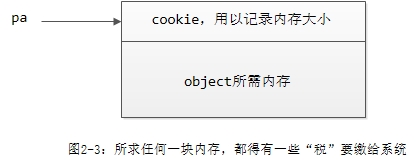
SGI第二级配置器的做法是,如果区块够大,超过128bytes时,就移交第一级配置器处理。当区块小于128bytes时,则以内存池(memory pool)管理,此法又称为次层配置(sub-allocation):每次配置一大块内存,并维护对应之自由链表(free-list)。下次若再有相同大小的内存需求,就直接从free-lists中拔出。如果客端释还小额区块,就由配置器回收到free-lists中————是的,别忘了,配置器除了负责配置,也负责回收。为了方便管理,SGI第二级配置器会主动将任何小额区块的内存需求量上调至8的倍数(例如客端要求30bytes,就自动调整为32bytes),并维护16个free-lists,各自管理大小分别为8,16,24,32,40,48,56, 64, 72, 80, 88, 96, 104, 112, 120, 128bytes的小额区块。free-lists的节点结构如下:
union _Obj {
union _Obj* _M_free_list_link;
char _M_client_data[1]; /* The client sees this. */
};诸君或许会想,为了维护链表(lists),每个节点需要额外的指针(指向下一个节点),这不又造成另一种额外负担吗?你的顾虑是对的,但早已有好的解决办法。注意,上述obj所用的是union,由于union之故,从其第一字段观之,obj可被视为一个指针,指向相同形式的另一个obj;从其第二字段观之,obj可被视为一个指针,指向实际区块。如图2-4所示。一物二用的结果是,不会为了维护链表所必须的指针而造成内存的另一种浪费(我们正在努力节省内存的开销呢)。这种技巧在强型(strongly typed)语言如Java中行不通,但是在非强型语言如C++中十分普遍。
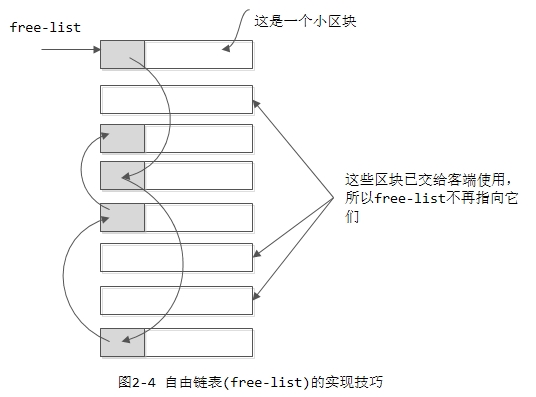
下面是第二级配置器的部分实现内容:
#if defined(__SUNPRO_CC) || defined(__GNUC__)
// breaks if we make these template class members:
enum {_ALIGN = 8}; //小型区块的上调边界
enum {_MAX_BYTES = 128}; //小型区块的上限
enum {_NFREELISTS = 16}; //free-lists个数
#endif
//以下是第二级配置器
//注意,无“template型别参数”,且第二参数完全没派上用场
//第一参数用于多线陈环境下。本书不讨论多线程环境
template <bool threads, int inst>
class __default_alloc_template {
//ROUND_UP将bytes上调至8的倍数
static size_t _S_round_up(size_t __bytes)
{ return (((__bytes) + (size_t) _ALIGN-1) & ~((size_t) _ALIGN - 1)); }
__PRIVATE:
union _Obj {
union _Obj* _M_free_list_link;
char _M_client_data[1]; /* The client sees this. */
};
private:
//16个free-lists
# if defined(__SUNPRO_CC) || defined(__GNUC__) || defined(__HP_aCC)
static _Obj* __STL_VOLATILE _S_free_list[];
// Specifying a size results in duplicate def for 4.1
# else
static _Obj* __STL_VOLATILE _S_free_list[_NFREELISTS];
# endif
//以下函数根据区块大小,决定使用第n号free-list。n从0起算
static size_t _S_freelist_index(size_t __bytes) {
return (((__bytes) + (size_t)_ALIGN-1)/(size_t)_ALIGN - 1);
// 返回一个大小为n的对象,并可能加入到free-list(Returns an object of size __n, and optionally adds to size __n free list)
static void* _S_refill(size_t __n);
// Allocates a chunk for nobjs of size size. nobjs may be reduced
// if it is inconvenient to allocate the requested number.
static char* _S_chunk_alloc(size_t __size, int& __nobjs);
// Chunk allocation state.
static char* _S_start_free; //内存池起始位置。只在chunk_alloc()中变化
static char* _S_end_free; //内存池结束位置。只在chunk_alloc()中变化
static size_t _S_heap_size;
public:
/* __n must be > 0 */
static void* allocate(size_t __n)
/* __p may not be 0 */
static void deallocate(void* __p, size_t __n);
static void* reallocate(void* __p, size_t __old_sz, size_t __new_sz);
};
//以下是static data member的定义与初值设定
template <bool __threads, int __inst>
char* __default_alloc_template<__threads, __inst>::_S_start_free = 0;
template <bool __threads, int __inst>
char* __default_alloc_template<__threads, __inst>::_S_end_free = 0;
template <bool __threads, int __inst>
size_t __default_alloc_template<__threads, __inst>::_S_heap_size = 0;
template <bool __threads, int __inst>
typename __default_alloc_template<__threads, __inst>::_Obj* __STL_VOLATILE
__default_alloc_template<__threads, __inst> ::_S_free_list[
# if defined(__SUNPRO_CC) || defined(__GNUC__) || defined(__HP_aCC)
_NFREELISTS
# else
__default_alloc_template<__threads, __inst>::_NFREELISTS
# endif
] = {0, 0, 0, 0, 0, 0, 0, 0, 0, 0, 0, 0, 0, 0, 0, 0, };2.7 空间配置函数allocate()
身为一个配置器,__default_alloc_template拥有配置器的标准接口函数allocate()。此函数首先判断区块大小,大于128bytes就调用第一级配置器,小于128bytes就检查对应的free-list。如果free-list之内有可用的区块,就直接拿来用;如果没有可用区块,就将区块大小上调至8倍数边界,然后调用refill(),准备为free list重新填充空间。refill()将于稍后介绍。
static void* allocate(size_t __n)
{
void* __ret = 0;
if (__n > (size_t) _MAX_BYTES) {
__ret = malloc_alloc::allocate(__n);
}
else {
_Obj* __STL_VOLATILE* __my_free_list = _S_free_list + _S_freelist_index(__n);
// Acquire the lock here with a constructor call.
// This ensures that it is released in exit or during stack
// unwinding.
# ifndef _NOTHREADS
/*REFERENCED*/
_Lock __lock_instance;
# endif
_Obj* __RESTRICT __result = *__my_free_list;
if (__result == 0)
__ret = _S_refill(_S_round_up(__n)); //没找到可用的free list,准备重新填充free list
else {
*__my_free_list = __result -> _M_free_list_link;
__ret = __result;
}
}
return __ret;
};区块自free list调出的操作,如下图2-5所示。

2.8 空间释放函数deallocate()
身为一个配置器,__default_alloc_template拥有配置器的标准接口函数deallocate()。该函数首先判断区块大小,大于128bytes就调用第一级配置器,小于128bytes就找出对应的free list,将区块回收。
/* __p may not be 0 */
static void deallocate(void* __p, size_t __n)
{
if (__n > (size_t) _MAX_BYTES)
malloc_alloc::deallocate(__p, __n);
else {
_Obj* __STL_VOLATILE* __my_free_list = _S_free_list + _S_freelist_index(__n);
_Obj* __q = (_Obj*)__p;
// acquire lock
# ifndef _NOTHREADS
/*REFERENCED*/
_Lock __lock_instance;
# endif /* _NOTHREADS */
//调整free list,回收区块
__q -> _M_free_list_link = *__my_free_list;
*__my_free_list = __q;
// lock is released here
}
}区块回收纳入free list的操作,如下图2-6所示。
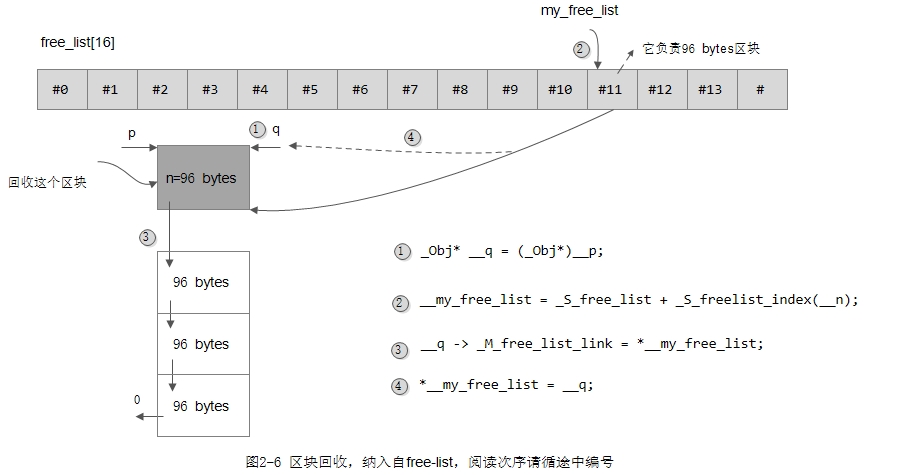
2.9 重新填充free lists
回头讨论先前说过的allocate()。当它发现free list中没有可用区块了时,就调用refill(),准备为free list重新填充空间。新的空间将取自内存池(经由chunk_alloc()完成)。缺省取得20个新节点(新区块),但万一内存池空间不足,获得的节点数(区块数)可能小于20:
//返回一个大小为n的对象,并且有时候会为适当的free list增加节点
//假设n已经适当上调至8的倍数
template <bool __threads, int __inst>
void* __default_alloc_template<__threads, __inst>::_S_refill(size_t __n)
{
int __nobjs = 20;
char* __chunk = _S_chunk_alloc(__n, __nobjs);
_Obj* __STL_VOLATILE* __my_free_list;
_Obj* __result;
_Obj* __current_obj;
_Obj* __next_obj;
int __i;
//如果只获得一个区块,这个区块就分配给调用者用,free list无新节点
if (1 == __nobjs) return(__chunk);
__my_free_list = _S_free_list + _S_freelist_index(__n);
/* Build free list in chunk */
__result = (_Obj*)__chunk;
*__my_free_list = __next_obj = (_Obj*)(__chunk + __n);
for (__i = 1; ; __i++) {
__current_obj = __next_obj;
__next_obj = (_Obj*)((char*)__next_obj + __n);
if (__nobjs - 1 == __i) {
__current_obj -> _M_free_list_link = 0;
break;
} else {
__current_obj -> _M_free_list_link = __next_obj;
}
}
return(__result);
}2.10 内存池(memory pool)
从内存池中取空间给free list使用,是chunk_alloc()的工作:
//假设size已经适当上调至8的倍数。请注意参数nobjs是paas by reference
template <bool __threads, int __inst>
char*
__default_alloc_template<__threads, __inst>::_S_chunk_alloc(size_t __size,
int& __nobjs)
{
char* __result;
size_t __total_bytes = __size * __nobjs;
size_t __bytes_left = _S_end_free - _S_start_free; //内存池剩余空间
if (__bytes_left >= __total_bytes) {
//内存池剩余空间完全满足需求量
__result = _S_start_free;
_S_start_free += __total_bytes;
return(__result);
} else if (__bytes_left >= __size) {
//内存池剩余空间不能完全满足需求量,但足够供应一个(含)以上的区块
__nobjs = (int)(__bytes_left/__size);
__total_bytes = __size * __nobjs;
__result = _S_start_free;
_S_start_free += __total_bytes;
return(__result);
} else {
//内存池剩余空间连一个区块的大小都无法提供
size_t __bytes_to_get = 2 * __total_bytes + _S_round_up(_S_heap_size >> 4);
// 以下试着让内存池中的残余零头还有利用价值
if (__bytes_left > 0) {
_Obj* __STL_VOLATILE* __my_free_list = _S_free_list + _S_freelist_index(__bytes_left);
((_Obj*)_S_start_free) -> _M_free_list_link = *__my_free_list;
*__my_free_list = (_Obj*)_S_start_free;
}
//配置heap空间,用来补充内存池
_S_start_free = (char*)malloc(__bytes_to_get);
if (0 == _S_start_free) {
//heap空间不足,malloc()失败
size_t __i;
_Obj* __STL_VOLATILE* __my_free_list;
_Obj* __p;
//试着检视我们手上拥有的东西。这不会造成伤害。我们不打算尝试配置较小的区块,因为那在多进程(multi-process)机器上容易导致
//灾难。以下搜寻适当的free list,所谓适当是指“尚有未用区块,且区块足够大”之free list
for (__i = __size; __i <= (size_t) _MAX_BYTES; __i += (size_t) _ALIGN) {
__my_free_list = _S_free_list + _S_freelist_index(__i);
__p = *__my_free_list;
if (0 != __p) { //free list尚有未用区块
*__my_free_list = __p -> _M_free_list_link;
_S_start_free = (char*)__p;
_S_end_free = _S_start_free + __i;
return(_S_chunk_alloc(__size, __nobjs));
//注意,任何残余零头终将被编入适当的free-list中备用
}
}
_S_end_free = 0; //如果出现意外(山穷水尽,到处都没内存可用了)
//调用第一级配置器,看看out-of-memory机制能否尽点力
_S_start_free = (char*)malloc_alloc::allocate(__bytes_to_get);
//这会导致抛出异常(exception),或内存不足的情况获得改善
}
_S_heap_size += __bytes_to_get;
_S_end_free = _S_start_free + __bytes_to_get;
//递归调用自己,为了修正nobjs
return(_S_chunk_alloc(__size, __nobjs));
}
}上述的chunck_alloc()函数以end_free - start_free来判断内存池的水量。如果水量充足,就直接调出20个区块返回给free list。如果水量不足以提供20个区块,但还足够供应一个以上的区块,就拔出这不足20个区块的空间出去。这时候其pass by reference的nobjs参数将被修改为实际能够供应的区块数。如果内存池连一个区块空间都无法供应,对客端显然无法交代,此时便利用malloc()从heap中配置内存,为内存池注入源头活水以应付需求。新水量的大小为需求量的两倍,再加上一个随着配置次数增加而愈来愈大的附加量。
举个例子,见图2-7,假设程序一开始,客端就调用chunk_alloc(32,20),于是malloc()配置40个32bytes区块,其中第1个交出,另19个交给free_list[3]维护,余20个留给内存池。接下来客端调用chunk_alloc(64, 20),此时free_list[7]空空如也,必须向内存池要求支持。内存池只够供应(32 x 20)/64 = 10个64bytes区块,就把这10个区块返回,第1个交给客端,余9个由free_list[7]维护。此时内存池全空。接下来调用chunk_alloc(96,20),此时free_list[11]空空如也,必须向内存池要求支持,而内存池此时也是空的,于是以malloc()配置40+n(附加量)个96bytes区块,其中第1个交出,剩余19个交给free_list[11]维护,余20+n(附加量)个区块留给内存池…
万一山穷水尽,整个system heap空间都不够了(以至无法为内存注入源头活水),malloc()行动失败,chunk_alloc()就四处寻找有无“尚有未用区块,且区块够大”之free_list。找到了就挖一块交出,找不到就调用第一级配置器。第一级配置器其实也是使用malloc()来配置内存,但它有out-of-memory处理机制(类似new-handler机制),或许有机会释放其他的内存拿来此处使用。如果可以,就成功,否则发出bad_alloc异常。
以上便是整个第二级空间配置器的设计。
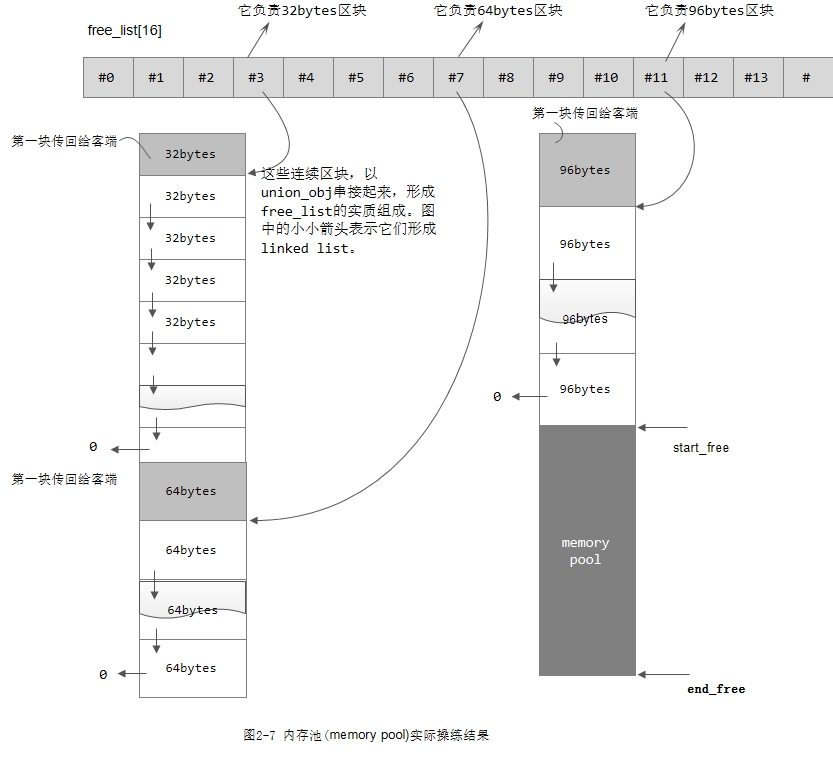
回想一下2.2.4节最后提到的那个提供配置器标准接口的simple_alloc:
template<class _Tp, class _Alloc>
class simple_alloc {
...
};SGI容器通常以这种方式来使用配置器:
template <class T, class Alloc = alloc> //缺省使用alloc配置器
class vector{
public:
typedef T value_type;
...
protected:
//专属之空间配置器,每次配置一个元素大小
typedef simple_alloc<value_type, Alloc> data_allocator;
...
};其中第二个template参数所接受的缺省参数alloc,可以是第一级配置器,也可以是第二级配置器。不过,SGI STL已经把它设为第二级配置器,见2.2.4节及图2-2b。
3. 内存基本处理工具
STL定义有五个全局函数,作用于未初始化空间上。这样的功能对于容器的实现很有帮助,我们会在第4章容器实现代码中,看到它们肩负的重任。前两个函数是2.2.3节说过的,用于构造的construct()和用于析构的destroy(),另三个函数是uninitialized_copy(), uninitialized_fill(), uninitialized_fill_n(),分别对应于高层次函数copy()、fill()、fill_n()————这些都是STL算法,将在第6章介绍。如果你要使用本节的三个低层次函数,应该包含
3.1 uninitialized_copy
template <class _InputIter, class _ForwardIter>
inline _ForwardIter
uninitialized_copy(_InputIter __first, _InputIter __last,
_ForwardIter __result);uninitialized_copy()使我们能够将内存的配置与对象的构造行为分离开来。如果作为输出目的地的[result, result + (last -first))范围内的每一个迭代器都指向未初始化区域,则uninitialized_copy()会使用copy constructor,给身为输入来源之[first, last)范围内的每一个对象产生一份复制品,放进输出范围中。换句话说,针对输入范围内的每一个迭代器i,该函数会调用construct(&*(result + (i - first)), *i),产生*i的复制品,放置于输出范围的相对位置上。式中的construct()已于2.2.3节讨论过。
如果你需要实现一个容器,uninitialized_copy()这样的函数会为你带来很大的帮助,因为容器的全区间构造函数(range constructor)通常以两个步骤完成:
-
配置内存区块,足以包含范围内的所有元素
-
使用uninitialized_copy(),在该内存区块上构造元素
C++标准规格书要求uninitialized_copy()具有“commit or rollback”语义,意思就是要么“构造出所有必要元素”,要么(当有任何一个copy constructor失败时)“不构造任何东西”。
3.2 uninitialized_fill
template <class _ForwardIter, class _Tp>
inline void uninitialized_fill(_ForwardIter __first,
_ForwardIter __last,
const _Tp& __x);uninitialized_fill()也能够使我们将内存配置与对象的构造行为分离开来。如果[first, last)范围内的每个迭代器都指向未初始化的内存,那么uninitialized_fill()会在该范围内产生x(上式第三参数)的复制品。换句话说,uninitialized_fill()会针对操作范围内的每个迭代器i,调用construct(&*i, x),在i所指之处产生x的复制品。式中construct()已于2.2.3节讨论过。
与uninitialized_copy()一样,uninitialized_fill()具有“commit or rollback”语义,它要么产生出所有必要元素,要么不产生任何元素。如果有任何一个copy constructor丢出异常(exception),uninitialized_fill()必须能够将已产生的所有元素析构掉。
3.3 uninitialized_fill_n
template <class _ForwardIter, class _Size, class _Tp>
inline _ForwardIter
uninitialized_fill_n(_ForwardIter __first, _Size __n, const _Tp& __x);uninitialized_fill_n()能够使我们将内存配置与对象行为分离开来,它会为指定范围内的所有元素设定相同的值。
如果[first, first+n)范围内的每一个迭代器都指向未初始化的内存,那么uninitialized_fill_n()会调用copy constructor,在该范围内产生x(上式第三参数)的复制品。也就是说,面对[first, first+n)范围内的每个迭代器i,uninitialized_fill_n()会调用construct(&*i, x),在对应位置处产生x的复制品。式中construct()已于2.2.3节讨论过。
uninitialized_fill_n()也具有“commit or rollback”语义:要么产生出所有必要元素,否则不产生任何元素。如果有任何一个copy constructor丢出异常(exception),uninitialized_fill_n()必须析构已产生的所有元素。
以下分别介绍这三哥函数的实现法。其中所呈现的iterators(迭代器)、value_type()、__type_traits、__true_type、__false_type、is_POD_type等实现技术,都将于第3章介绍。
1) uninitialized_fill_n
首先是uninitialized_fill_n()的源代码,本函数接受三个参数:
- 迭代器first指向欲初始化空间的起始处
- n表示欲初始化空间的大小
- x表示初值
template <class _ForwardIter, class _Size, class _Tp>
inline _ForwardIter
uninitialized_fill_n(_ForwardIter __first, _Size __n, const _Tp& __x)
{
return __uninitialized_fill_n(__first, __n, __x, __VALUE_TYPE(__first));
}注:上面利用__VALUE_TYPE()取出first的value type
这个函数的进行逻辑是,首先萃取出迭代器first的value type(详见第3章),然后判断该型别是否为POD型别:
template <class _ForwardIter, class _Size, class _Tp, class _Tp1>
inline _ForwardIter
__uninitialized_fill_n(_ForwardIter __first, _Size __n, const _Tp& __x, _Tp1*)
{
typedef typename __type_traits<_Tp1>::is_POD_type _Is_POD;
return __uninitialized_fill_n_aux(__first, __n, __x, _Is_POD());
}注:关于__type_traits的用法,详见3.7节
POD意指Plain Old Data,也就是标量型别(scalar types)或传统的C struct型别。POD型别必然拥有trival ctor/dtor/copy/assignment,因此,我们可以对POD型别采用最有效率的初值填写手法,而对non-POD型别采用最保险安全的做法:
//如果copy construction等同于assignment,而且destructor是trival,以下就有效。
//如果是POD型别,执行流程就会转进到以下函数。这是藉由function template的参数推导机制而得
template <class _ForwardIter, class _Size, class _Tp>
inline _ForwardIter
__uninitialized_fill_n_aux(_ForwardIter __first, _Size __n,
const _Tp& __x, __true_type)
{
return fill_n(__first, __n, __x);
}
//如果不是POD型别,执行流程就会转进到以下函数。这是藉由function template的参数推导机制而得
template <class _ForwardIter, class _Size, class _Tp>
_ForwardIter
__uninitialized_fill_n_aux(_ForwardIter __first, _Size __n,
const _Tp& __x, __false_type)
{
_ForwardIter __cur = __first;
__STL_TRY {
for ( ; __n > 0; --__n, ++__cur)
_Construct(&*__cur, __x);
return __cur;
}
__STL_UNWIND(_Destroy(__first, __cur));
}2) uninitialized_copy
下面列出uninitialized_copy()的源代码,本函数接受三个参数:
- 迭代器first指向输入端的起始位置
- 迭代器last指向输入端的结束位置(前闭后开区间)
- 迭代器result指向输出端(欲初始化空间)的起始处
template <class _InputIter, class _ForwardIter>
inline _ForwardIter
uninitialized_copy(_InputIter __first, _InputIter __last,
_ForwardIter __result)
{
return __uninitialized_copy(__first, __last, __result,
__VALUE_TYPE(__result));
}这个函数的进行逻辑是,首先萃取出迭代器result的value type(详见第3章),然后判断型别是否为POD型别:
template <class _InputIter, class _ForwardIter, class _Tp>
inline _ForwardIter
__uninitialized_copy(_InputIter __first, _InputIter __last,
_ForwardIter __result, _Tp*)
{
typedef typename __type_traits<_Tp>::is_POD_type _Is_POD;
return __uninitialized_copy_aux(__first, __last, __result, _Is_POD());
}POD意指Plain Old Data,也就是标量型别(scalar types)或传统的C struct型别。POD型别必然拥有trival ctor/dtor/copy/assignment,因此,我们可以对POD型别采用最有效率的复制手法,而对non-POD型别采用最保险安全的做法:
//如果copy construction等同于assignment,而且destructor是trival,以下就有效。
//如果是POD型别,执行流程就会转进到以下函数。这是藉由function template的参数推导机制而得
template <class _InputIter, class _ForwardIter>
inline _ForwardIter
__uninitialized_copy_aux(_InputIter __first, _InputIter __last,
_ForwardIter __result,
__true_type)
{
return copy(__first, __last, __result);
}
//如果不是POD型别,执行流程就会转进到以下函数。这是藉由function template的参数推导机制而得
template <class _InputIter, class _ForwardIter>
_ForwardIter
__uninitialized_copy_aux(_InputIter __first, _InputIter __last,
_ForwardIter __result,
__false_type)
{
_ForwardIter __cur = __result;
__STL_TRY {
for ( ; __first != __last; ++__first, ++__cur)
_Construct(&*__cur, *__first);
return __cur;
}
__STL_UNWIND(_Destroy(__result, __cur));
}针对char *和wchar_t *两种型别,可以采用最具效率的做法memmove(直接移动内存内容)来复制行为。因此SGI得以为这两种型别设计一份特化版本。
//以下是针对const char *的特化版本
inline char* uninitialized_copy(const char* __first, const char* __last,
char* __result) {
memmove(__result, __first, __last - __first);
return __result + (__last - __first);
}
//以下是针对const wchar_t *的特化版本
inline wchar_t*
uninitialized_copy(const wchar_t* __first, const wchar_t* __last,
wchar_t* __result)
{
memmove(__result, __first, sizeof(wchar_t) * (__last - __first));
return __result + (__last - __first);
}3) uninitialized_fill
下面列出uninitialized_fill的源代码,本函数接受三个参数:
- 迭代器first指向输出端(欲初始化空间)的起始处
- 迭代器first指向输出端(欲初始化空间)的结束处(前闭后开区间)
- x表示初值
template <class _ForwardIter, class _Tp>
inline void uninitialized_fill(_ForwardIter __first,
_ForwardIter __last,
const _Tp& __x)
{
__uninitialized_fill(__first, __last, __x, __VALUE_TYPE(__first));
}这个函数的进行逻辑是,首先萃取出迭代器result的value type(详见第3章),然后判断型别是否为POD型别:
template <class _ForwardIter, class _Tp, class _Tp1>
inline void __uninitialized_fill(_ForwardIter __first,
_ForwardIter __last, const _Tp& __x, _Tp1*)
{
typedef typename __type_traits<_Tp1>::is_POD_type _Is_POD;
__uninitialized_fill_aux(__first, __last, __x, _Is_POD());
}POD意指Plain Old Data,也就是标量型别(scalar types)或传统的C struct型别。POD型别必然拥有trival ctor/dtor/copy/assignment,因此,我们可以对POD型别采用最有效率的初值填写手法,而对non-POD型别采用最保险安全的做法:
//如果copy construction等同于assignment,而且destructor是trival,以下就有效。
//如果是POD型别,执行流程就会转进到以下函数。这是藉由function template的参数推导机制而得
template <class _ForwardIter, class _Tp>
inline void
__uninitialized_fill_aux(_ForwardIter __first, _ForwardIter __last,
const _Tp& __x, __true_type)
{
fill(__first, __last, __x);
}
//如果不是POD型别,执行流程就会转进到以下函数。这是藉由function template的参数推导机制而得
template <class _ForwardIter, class _Tp>
void
__uninitialized_fill_aux(_ForwardIter __first, _ForwardIter __last,
const _Tp& __x, __false_type)
{
_ForwardIter __cur = __first;
__STL_TRY {
for ( ; __cur != __last; ++__cur)
_Construct(&*__cur, __x);
}
__STL_UNWIND(_Destroy(__first, __cur));
}图2-8以图形显式本节三个函数对效率的特殊考虑。

[参看]:

